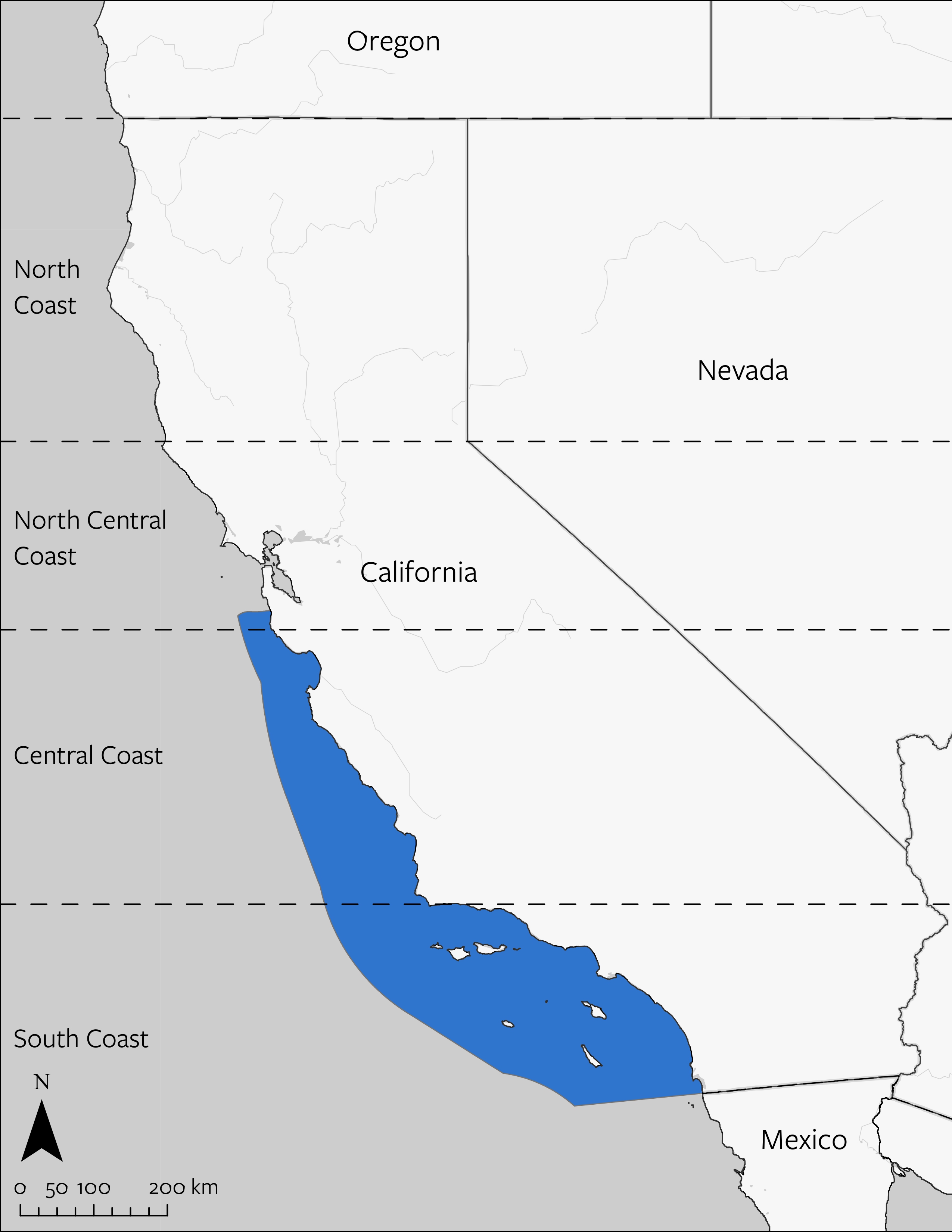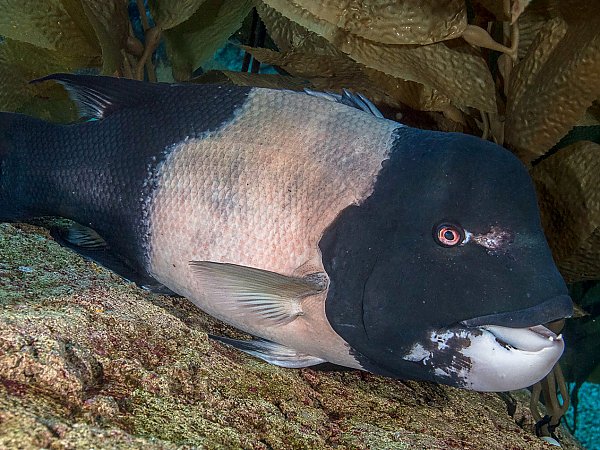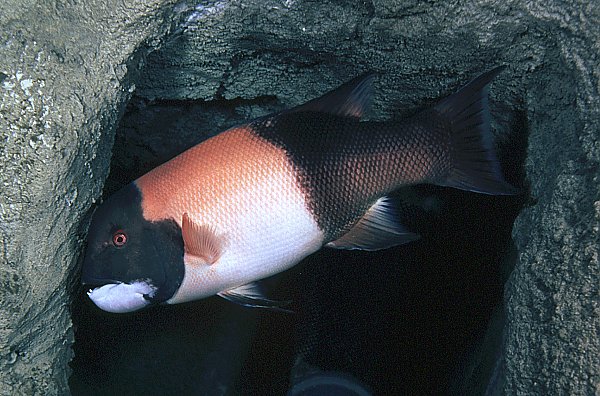California Sheephead
Bodianus pulcher
California Sheephead
Bodianus pulcher
California sheephead populations are relatively stable as a result of management measures such as seasonal closures and bag limits.
Morphology
The California sheephead is a generalist carnivore with prominent, canine-like teeth that allow them to pry prey from rocks, and a special plate in their throat that allows them to crush hard shells for easier digestion. California sheephead can grow up to 90 centimeters in length and weigh over 16 kilograms. Males and females have distinct appearances. Females are uniformly reddish pink, whereas males have a black head and tail with a reddish middle section.
Habitat and Range
California sheephead’s range extends from Monterey Bay, California to the Gulf of California, Mexico. These fish are typically found at depths between 3 and 85 meters. Sheephead strongly favor rocky bottom areas, which provide shelter and abundant prey. Within rocky reef habitats, sheephead show a preference for those areas with greater structural complexity, which afford some protection from predators.
Range Map

Reproductive Biology and Life History
All sheephead begin life as females and can then change their sex to male later in life. The transition from female to male usually occurs between 5-13 years of age, influenced by social and environmental factors. Sheephead live in harems in which the largest fish is male. When the male is removed (often because they are caught in recreational fishing) the largest female will change sex to male. Sheephead are batch broadcast spawners, releasing eggs and sperm into the water column multiple times during their spawning season, typically from July to September. During the spawning season, males establish and defend territories, protecting areas up to 20 meters long. They have a long lifespan, with the oldest reported individual being a 53-year-old male.
Ecology
Until very recently, California sheephead were placed in the genus Semicossyphus. This nomenclature has been revised so that they are now placed in the genus Bodianus. They are close relatives to Darwin’s sheephead in the Galapagos Islands.
California sheephead are generalist carnivores, with a diet that changes with age. As juveniles, sheephead primarily consume small invertebrates like tube-dwelling polychaetes, bryozoans, and brittle stars. As adults, they shift to larger mobile invertebrates, with a focus on sea urchins. In fact, because of their preference for urchins, California sheephead act as keystone predators in kelp forest ecosystems. By killing and consuming sea urchins, sheephead reduce the risk of urchin outbreaks that overgraze kelp to the point of creating a barren ocean floor.
California sheephead are considered resident species with high site fidelity. Their average home range is approximately 600 square meters. In spite of this tendency towards site fidelity, genetic data indicate a high level of genetic exchange, which suggests ample dispersal among populations.
Cultural Significance and Historical Context
Native Americans, particularly the Chumash people of the Channel Islands, used California sheephead for thousands of years. Remains of the fish have been found in Chumash archeological sites on Santa Rosa, Santa Cruz, San Miguel and Anacapa Islands. In many of these archaeological sites, sheephead were the most abundant food item, suggesting their importance in the diet and abundance in the wild.
The westward expansion of European colonists as well as the development of cities within California created an economic opportunity for an expanding sheephead fishery. Initially, Chinese fishermen caught modest numbers of sheephead in the late 1800s for drying and salting. This was followed in the 1900s by two booms of sheephead commercial harvest. The first boom occurred between 1925 and 1951, with a peak harvest of 169,190 kilograms in 1928. The second boom occurred in the 1990s when smaller, juvenile sheephead were sold primarily to the live fish market and Asian restaurants. In the period between these two booms, sheephead averaged fewer than 7,300 kilograms captured each year – less than one tenth of earlier peak harvests.
Date modified: January 2025
This animal can be found at the Aquarium of the Pacific
Primary ThreatsPrimary Threats Conditions
Threats and Conservation Status
Sheephead are currently managed with seasonal closures, minimum bag and size limits, and Marine Protected Areas (MPA’s). Both commercial and recreational fishing are restricted to larger fish, which are predominantly male, leaving smaller females free from harvest. From the perspective of minimizing any risk of extinction, this targeting of only larger fish seems to be effective. Following the implementation of a minimum size limit in 2001, capture data from recreational fisheries show that 87% of the captured fish are between 7 and 14 years of age. Given that sheephead mature at ~4 years of age, this means most of the harvested fish had reproduced a minimum of three times before they were taken.
Marine Protected Areas benefit sheephead in a different way. By closing an area to fishing, MPA’s in theory should lead to a buildup of sheephead populations inside the protected area and an increase in the size of the fish because the larger males are not caught each year. This has in fact been observed for sheephead – both growing populations inside MPA’s and larger fish inside MPA’s. The larger size of sheephead inside MPA’s is significant because it translates to better control of urchin populations.
The overall sheephead population story is one of weak positive trends in population growth within MPA’s (~ 2% annually in South Coast and 5% annually in the Central coast). Outside MPA’s, sheephead populations in both south and central coast areas are stable. Overall it is classified as stable with fluctuations.
Population Plots






Data Source: Monitoring and Evaluation of Kelp Forest Ecosystems in the MLPA Marine Protected Area Network. California Ocean Protection Council Data Repository. North and North Central regions were all zeroes, and hence those regions were dropped.


